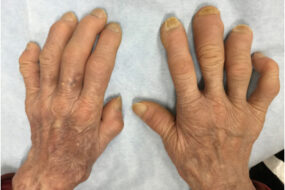- Home
- INTERNAL MEDICINE
- Pulmonary Valve Stenosis

Pulmonary Valve Stenosis (PVS) is a congenital heart defect characterized by the narrowing of the pulmonary valve, which impedes blood flow from the right ventricle to the pulmonary artery and, subsequently, to the lungs. This condition can be isolated or part of a more complex cardiac anomaly.
Pathophysiology
- Anatomy of the Pulmonary Valve
- The pulmonary valve is a semilunar valve located between the right ventricle and the pulmonary artery, consisting of three cusps: anterior, left, and right.
- Types of Pulmonary Valve Stenosis
- Valvular Stenosis: The most common form, where the valve cusps are thickened, domed, or fused, leading to a narrowed orifice.
- Subvalvular Stenosis: Rare and involves fibrous or muscular obstruction beneath the valve.
- Supravalvular Stenosis: Also rare, this involves narrowing of the pulmonary artery just above the valve.
- Hemodynamic Consequences
- The narrowing of the valve leads to an increase in right ventricular pressure (pressure overload) during systole.
- This results in right ventricular hypertrophy (RVH) over time due to the compensatory mechanism to overcome the outflow obstruction.
- Severe stenosis may lead to right heart failure and reduced cardiac output.
Clinical Presentation
- Symptoms
- Mild to Moderate Stenosis: Often asymptomatic, particularly in early childhood. Symptoms may include:
- Exercise intolerance
- Fatigue
- Dyspnea on exertion
- Severe Stenosis: Symptoms may manifest earlier and can include:
- Cyanosis (in cases of severe obstruction)
- Chest pain (angina)
- Syncope or pre-syncope during exertion
- Heart failure symptoms (e.g., edema, hepatomegaly, ascites) in severe cases.
- Mild to Moderate Stenosis: Often asymptomatic, particularly in early childhood. Symptoms may include:
- Physical Examination Findings
- Murmur: A characteristic systolic ejection murmur best heard at the left upper sternal border, often accompanied by a click (due to a thickened valve).
- Pulses: May be normal or diminished, depending on the severity of stenosis.
- Signs of Right Heart Failure: In severe cases, signs such as peripheral edema, jugular venous distension, and hepatomegaly may be present.
- Associated Anomalies
- Tetralogy of Fallot: PVS may occur in conjunction with this complex congenital heart defect.
- Other Congenital Heart Defects: Can be associated with conditions like atrial septal defect (ASD) or ventricular septal defect (VSD).
Diagnosis
- Imaging Studies
- Echocardiography: The primary diagnostic tool. Key findings include:
- Thickened valve cusps
- Narrowed outflow tract
- Increased right ventricular pressure and hypertrophy.
- Doppler imaging to assess the peak gradient across the valve.
- Cardiac Catheterization: Reserved for complex cases. It allows direct measurement of pressures and gradient across the valve and may aid in interventions.
- Magnetic Resonance Imaging (MRI): Useful for detailed anatomical assessment, especially in complex congenital heart disease.
- Echocardiography: The primary diagnostic tool. Key findings include:
- Electrocardiogram (ECG)
- May show right axis deviation and signs of right ventricular hypertrophy.
- Chest X-Ray
- May show an enlarged right ventricle and pulmonary arteries, particularly in cases of severe stenosis.
Management
- Observation
- Asymptomatic patients with mild stenosis may require regular follow-up with echocardiography to monitor for progression.
- Medical Management
- There are no specific pharmacological treatments for PVS. However, beta-blockers may be used to manage exertional symptoms in some cases.
- Interventional Procedures
- Balloon Valvuloplasty: The primary treatment for moderate to severe PVS in children and adults. This minimally invasive procedure involves:
- Insertion of a catheter with a balloon at the tip into the narrowed area.
- Inflation of the balloon to widen the valve opening.
- Typically performed in a cardiac catheterization lab under fluoroscopy and sedation.
- Surgical Intervention: Indicated if balloon valvuloplasty is ineffective or if there is significant associated pathology (e.g., significant RVH, heart failure symptoms). Options include:
- Surgical valvotomy: Resection of the obstructive tissue.
- Valve replacement: In severe cases, particularly when there is significant regurgitation or additional pathology.
- Balloon Valvuloplasty: The primary treatment for moderate to severe PVS in children and adults. This minimally invasive procedure involves:
- Follow-Up and Long-Term Management
- Regular follow-up is essential, particularly for those who undergo balloon valvuloplasty. Echocardiography should be performed periodically to assess for recurrence of stenosis or new complications.
- Patients should be educated about potential complications and symptoms that warrant immediate medical attention (e.g., worsening dyspnea, chest pain).
Prognosis
- The prognosis for patients with PVS is generally good, especially with appropriate intervention.
- Most individuals can lead a normal life after successful treatment.
- Long-term complications, if untreated, may include progressive right ventricular hypertrophy, heart failure, arrhythmias, and increased risk of sudden cardiac death.












